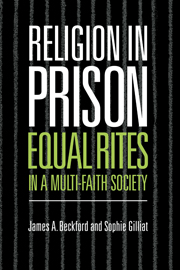Book contents
- Frontmatter
- Contents
- List of figures
- List of tables
- Abbreviations
- Preface
- 1 Equal opportunities and multiculturalism in prisons
- 2 Chaplaincy, chaplains, chapels and other faiths
- 3 Church of England prison chaplains
- 4 Visiting Ministers of other faiths
- 5 ‘Facilitation’ or ‘dependence’?
- 6 Inclusion and exclusion
- 7 Prison chaplaincy in the United States
- 8 Conclusions: state, church and diversity
- Notes
- Appendix
- References
- Index
2 - Chaplaincy, chaplains, chapels and other faiths
Published online by Cambridge University Press: 22 August 2009
- Frontmatter
- Contents
- List of figures
- List of tables
- Abbreviations
- Preface
- 1 Equal opportunities and multiculturalism in prisons
- 2 Chaplaincy, chaplains, chapels and other faiths
- 3 Church of England prison chaplains
- 4 Visiting Ministers of other faiths
- 5 ‘Facilitation’ or ‘dependence’?
- 6 Inclusion and exclusion
- 7 Prison chaplaincy in the United States
- 8 Conclusions: state, church and diversity
- Notes
- Appendix
- References
- Index
Summary
The current arrangements for providing the inmates of prisons in England and Wales with pastoral and religious care have evolved from earlier types of prison regimes in which the Christian religion was dominant and Church of England clergy were the only chaplains. It is still true that Christianity is the dominant religious force in prisons, but two things have changed. The first is that religions other than Christianity, or ‘other faiths’, are now represented to varying degrees among the staff and inmates of most prisons, with the result that a variety of types of pastoral and religious care is available. The second change is that Church of England clergy now work not only alongside Roman Catholic and Free Church chaplains in increasingly inter-denominational schemes of co-operation but also alongside ‘Visiting Ministers’ representing other faiths. Both of these Changes are a consequence of the growth of religious diversity in British society inside and outside prisons.
How is pastoral and religious care provided? What are the statutory, administrative and customary requirements affecting its delivery? What kind of personnel delivers this care? In what conditions do they work? And how many prisoners register as potential beneficiaries? This chapter will begin to answer these questions and will set the scene for the more fundamental question of whether all prisoners have an equal opportunity to receive pastoral and religious care which is appropriate to their religious identity.
- Type
- Chapter
- Information
- Religion in Prison'Equal Rites' in a Multi-Faith Society, pp. 25 - 55Publisher: Cambridge University PressPrint publication year: 1998



